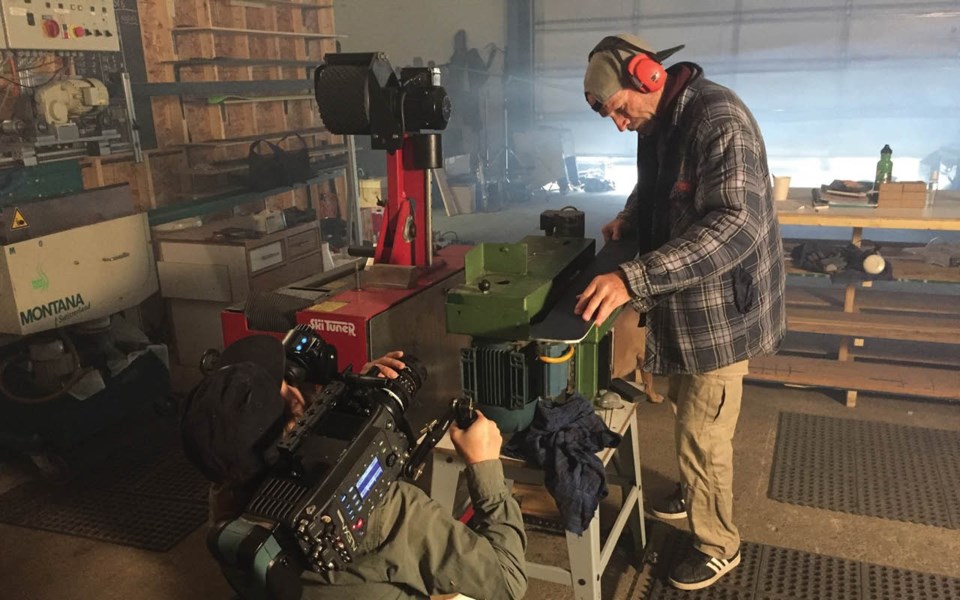In a nondescript Pemberton warehouse, around the back through a nondescript door, Johnny "Foon" Chilton hunches over a vice in a cavernous space, working on a surfboard fin.
Just back from Mexico he looks relaxed, casual and very Canadian in a plaid jacket and red Foon Skis ballcap. "I got a new board and don't really like the fin set up," he says. "I'm hoping I can modify it a bit."
Modifying and tinkering is something Johnny does well. And in the nine years he's been hand making Foon Skis, he's done plenty. "Before moving here, I worked in a cabinet-making shop in Vancouver, and a lot of the tool skills are very similar," he begins.
We step over to an old ski press where Johnny scrapes leftover epoxy from a metal cassette in which ski lay-ups are pressed. "I hadn't been thinking about making skis," says the former pro ski mountaineer with an impressive résumé of first descents, "but a friend directed me to a website that showed you how to make a capped ski in a vacuum bag, which was easier than a sandwich ski."
For about $1,000 worth of material and a bit of his time it seemed like a fun project. His wife's mother heard about it and bought him a vacuum bag for Christmas. "I made a pair and they were OK; then I made another pair that skied really well, and boom, I was hooked."
He started making skis in his basement in 2009, quit his job at Whistler Blackcomb in 2012, and has been at it full-time since. In 2011 he abandoned cap skis for the press. "If you really want to make a good ski and have control over all the parameters, you need to move to sandwiching," he says.
Foon skis are special, not only an act of handmade love but a paean to the coastal mountain environment. When it comes to local sourcing and company identity, Foon has walked the walk from Day 1, waxing poetic about the subalpine coastal yellow cedar he uses in the core of skis crafted for conditions that include those very forests. It's a unique and direct connection.
His open-concept production space features a coastal workshop vibe—snowmobiles in a corner, walls lined by skis, two presses separated by a rack for core laminates and top sheets, a shelving unit for base sets and a chalkboard inventory, a whiteboard to track orders, and an old base grinder from the Carlton Lodge. Foon, who now has three employees, built a woodworking shop to one side that contains the dust from that activity; above it on a mezzanine are stacked cedar planks—though he also uses local aspen and big-leaf maple.
The old ski press was OK for the low number of seven different models he has been producing until now, but he has big plans for the new press which can pump out three to four pairs a day. This will be used for a new ski-design venture with big-mountain ripper Kye Petersen—Kye Shapes. Foon expects this year's production total to be 300 pairs of skis—200 originals and 100 Kye Shapes, with the balance switching around the following year. It's a big change from the 100 pairs/year he was making, but there's a reason—Foon also recently partnered with Gibbons Life, providing the capital necessary to make that leap.
"I was at the point where I was going to either have to move back to the basement and be content to make a handful of skis a year, or find a way to leap to larger production numbers," he notes. "Then I started talking to Joey Gibbons. Both our kids are in the Whistler Mountain racing program so we ended up riding chairs together. Joey was wondering aloud what he was going to do next and I said 'How about skis'?"
Foon sees Gibbons as an idealist who loves the place he grew up and is interested in creating identity and supporting local business and causes. "It was a great fit for me that came at just the right time."
Photographer Blake Jorgenson and Sherpas Cinema are both in the shop when I visit, working on collateral for the partnership that reflects the hand-crafted alchemy of this unique business; special lighting and a smoke machine create visual trickery to support the trope.
When they get down to shooting, Johnny poses with his chill dog Max at his feet and a "Moma Lisa" in hand—a ski celebrating his wife, the late ski guide Lisa Korthals. Johnny appears with the ski out of a swirl of smoke like a wizard with a green wand in hand.
"Lisa worked with me on my original ski, and then one for her that was a bit softer; she really loved the 169-centimetre version even if her hardcore friends ribbed her about how short it was. So that was the ski we made in her memory. We've already sold 27 pairs—our most popular ski ever."
What better tribute to both of them.
Leslie Anthony is a Whistler-based author, editor, biologist and bon vivant who has never met a mountain he didn't like.




